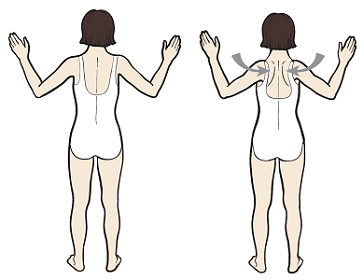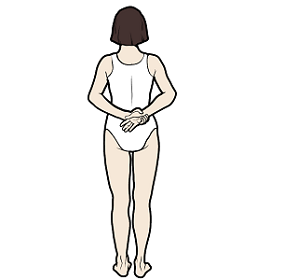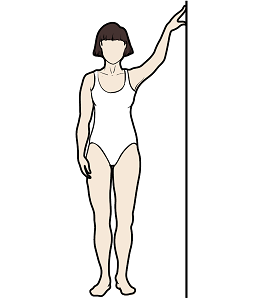This information explains the exercises you will do after your lumpectomy or axillary lymph node procedure. Doing these exercises will help you get back your full range of motion.
You can do these exercises on the first day after your procedure if your surgeon tells you it’s safe.
Deep breathing exercise
Deep breathing can help you relax and ease discomfort and tightness around your incision (surgical cut). It’s also a good way to relieve stress during the day.
- Sit comfortably in a chair.
- Take a slow, deep breath in through your nose. Let your chest and belly expand.
- Breathe out slowly through your mouth.
Repeat as many times as you want to.
Arm and shoulder exercises
Doing arm and shoulder exercises will help you get back your full range of motion on your affected side. Your affected side is the side where you had your procedure. Your range of motion is how much you can safely move a part of your body.
With full range of motion, you will be able to:
- Move your arm over your head and out to the side.
- Move your arm behind your neck.
- Move your arm to the middle of your back.
When to do these exercises
Do these exercises 3 times every day until you can move your affected arm the way you did before your procedure. After that, keep doing them once a day. This often is important if you still feel tightness in your chest, shoulder, or under your affected arm. These exercises can help keep scar tissue from forming in your armpit and shoulder. Scar tissue can limit your arm movements later.
If you still have trouble moving your shoulder 4 weeks after your procedure, tell your surgeon. They will tell you if you need more rehabilitation, such as physical or occupational therapy.
Supplies
You will need these supplies:
- A stopwatch, timer, or watch with a second hand. You will use this to time some exercises.
- 4 pieces of tape. You will use these to mark your progress with some exercises.
Instructions
Do the exercises in the order they’re listed here. Remember to follow your care team’s instructions for when to start each exercise.
Backward shoulder rolls
This is a good exercise to start with. It gently stretches your chest and shoulder muscles.
- Stand or sit comfortably with your arms relaxed at your sides.
-
In a circular motion, bring your shoulders forward, up, backward, and down (see Figure 1). Try to make the circle as big as you can and move both shoulders at the same time.

Figure 1. Backward shoulder rolls - Repeat this movement 5 times. If you feel tightness across your incision or chest, start with smaller circles. Make them bigger as the tightness lessens.
When this exercise starts to feel easier, start doing the movement an extra time. Build up to repeating it 10 times.
Shoulder wings
This exercise will help you get back outward movement of your shoulder. You can do it while sitting or standing.
- Place your hands on your chest or collarbone.
-
Raise your elbows out to the side. Raise them as high as you can, up to shoulder level (see Figure 2).
- If you feel discomfort near your incision, hold your position and do the deep breathing exercise. If the discomfort goes away, raise your elbows a little higher. If the discomfort does not go away, do not raise your elbows any higher.

- Slowly lower your elbows.
- Repeat this movement 5 times. When you’re done, slowly lower your hands.
When this exercise starts to feel easier, start doing the movement an extra time. Build up to repeating it 10 times.
Backward arm circles
If your procedure was done on both breasts, do this exercise with one arm at a time. Doing it with both arms at once will put too much pressure on your chest.
-
Stand with your feet slightly apart for balance. Raise your affected arm out to the side as high as you can (see Figure 3).

Figure 3. Backward arm circles - Start making slow, backward circles in the air with your arm. Make sure you’re moving your arm from your shoulder, not your elbow. Keep your elbow straight.
-
Repeat this movement 5 times. Make each circle larger until they’re as big as you can comfortably make them.
- If you feel any aching or if your arm gets tired, take a break. Keep going when you feel better.
- When you’re done, slowly lower your arm to your side.
When this exercise starts to feel easier, start doing the movement an extra time. Build up to repeating it 10 times.
Forward arm circles
Follow the same instructions as for backward arm circles but make slow, forward circles.
Make sure to rest your arm for a moment between doing backward and forward arm circles.
W exercise
You can do this exercise while sitting or standing.
-
Form a “W” with your arms out to the side and palms facing forward (see Figure 4). Try to bring your hands up so they’re even with your face. If you cannot raise your arms that high, bring them to the highest comfortable position.

Figure 4. W exercise -
Pinch your shoulder blades together and downward, as if you’re squeezing a pencil between them. Keep squeezing them together and downward for 5 seconds.
- If you feel discomfort near your incision, hold your position and do the deep breathing exercise. If the discomfort goes away, try to bring your arms back a little further. If the discomfort does not go away, do not reach any further. Hold the furthest position you can and squeeze your shoulder blades together for 5 seconds.
- Slowly bring your arms back to the starting position.
- Repeat this movement 5 times. When you’re done, slowly lower your hands.
When this exercise starts to feel easier, start doing the movement an extra time. Build up to repeating it 10 times.
Back climb
You can do this exercise while sitting or standing. You will need a stopwatch, timer, or watch with a second hand for this exercise.
-
Place your hands behind your back. Hold the hand on your affected side with your other hand (see Figure 5). If your procedure was done on both breasts, use the arm that moves most easily to hold the other.

Figure 5. Back climb -
Slowly slide your hands up the center of your back as far as you can. You should feel a gentle stretch in your shoulder area. Remember to breathe normally.
- If you feel tightness near your incision, hold your position and do the deep breathing exercise. If the tightness lessens, try to slide your hands up a little further. If it does not, leave your hands where they are.
- Hold this position for 30 seconds. Use a stopwatch, timer, or watch with a second hand to keep track. After 30 seconds, slowly lower your hands.
When this exercise starts to feel easier, start holding the position for a little longer. Build up to holding it for 60 seconds (1 minute).
Hands behind neck
You will need a stopwatch, timer, or watch with a second hand for this exercise.
The first few times you do this exercise, do it while lying comfortably on your back on your bed. Place a pillow under your head. You can also roll up a small or medium towel and place it under the middle of your back, along your spine. This will help open up the front of your chest.
Once you’re comfortable doing this exercise while lying on your back, you can do it while sitting or standing.
- Put your hands together on your lap or in front of you.
-
Slowly raise your hands toward your head. Keep your elbows together in front of you, not out to the sides (see Figure 6). Keep your head level. Do not bend your neck. Keep your shoulder blades squeezed together.

Figure 6. Hands behind neck -
Slide your hands over your head until you reach the back of your neck. When you get to this point, spread your elbows out to the sides.
- If you feel tightness across your incision or chest, hold your position and do the deep breathing exercise. It’s OK to rest your hands on your head if you need to. If the tightness lessens, continue with the movement. If it does not, do not move any further.
- Hold the highest position you can for 30 seconds. Use a stopwatch, timer, or watch with a second hand to keep track. Remember to breathe normally. After 30 seconds, slowly bring your elbows back together, slide your hands over your head, and lower your arms.
When this exercise starts to feel easier, start holding the position for a little longer. Build up to holding it for 60 seconds (1 minute).
Side wall crawls
You will need 2 pieces of tape for this exercise.
You should not feel pain while doing this exercise. It’s normal to feel some tightness or pulling across the side of your chest. Focus on your breathing until the tightness lessens.
Be careful not to turn your body toward the wall while doing this exercise. Make sure only the side of your body faces the wall.
If your procedure was done on both breasts, start with step 3.
- Stand with your unaffected side closest to the wall, about 1 foot (30.5 centimeters) away from the wall. Your unaffected side is the side where you did not have your procedure.
-
Reach as high as you can with your unaffected arm. Mark that point with a piece of tape (see Figure 7). This will be the goal for your affected arm.

Figure 7. Side wall crawls - Turn your body so your affected side is now closest to the wall. If your procedure was done on both breasts, start with either side closest to the wall.
- Crawl your fingers up the wall as far as you can. Remember to breathe normally.
- When you get to the point where you feel a good stretch, but not pain, do the deep breathing exercise.
- Return to the starting position by crawling your fingers back down the wall.
- Repeat this movement 5 times.
- After your last crawl, use a piece of tape to mark the highest point you reached with your affected arm. This will let you see your progress each time you do the exercise.
- If your procedure was done on both breasts, repeat the exercise with your other arm.
When this exercise starts to feel easier, start doing the movement an extra time. Build up to repeating it 10 times.
Forward wall crawls
You will need 2 pieces of tape for this exercise.
- Stand facing a wall. Your toes should be about 6 inches (15 centimeters) from the wall.
- Reach as high as you can with your unaffected arm. Mark that point with a piece of tape. This will be the goal for your affected arm. If your procedure was done on both breasts, set your goal using the arm that moves most comfortably.
-
Place both hands against the wall at a level that’s comfortable. Crawl your fingers up the wall as far as you can, keeping them even with each other (see Figure 8). Try not to look up toward your hands or arch your back.

Figure 8. Forward wall crawls - When you get to the point where you feel a good stretch, but not pain, do the deep breathing exercise.
- Return to the starting position by crawling your fingers back down the wall.
- Repeat this movement 5 times. Each time you raise your hands, try to crawl a little bit higher.
- After the last crawl, use the other piece of tape to mark the highest point you reached with your affected arm. This will let you see your progress each time you do the exercise.
As you become more flexible, you may need to take a step closer to the wall. This will let you reach a little higher.
When this exercise starts to feel easier, start doing the movement an extra time. Build up to repeating it 10 times.
Tips for managing swelling
After your procedure, you may have some swelling or puffiness in your hand or arm on your affected side. This is normal and usually goes away on its own.
If you notice swelling in your hand or arm, follow these tips to help the swelling go down.
-
Raise your arm above the level of your heart and do hand pumps several times a day.
- To do hand pumps, slowly open and close your fist 10 times. This will help drain the fluid out of your arm.
- Do not hold your arm straight up over your head for more than a few minutes. This can cause your arm muscles to get tired.
- Raise your arm to the side a few times a day for about 20 minutes at a time. To do this, sit or lie down on your back. Rest your arm on a few pillows next to you so it’s raised above the level of your heart.
- If you’re able to sleep on your unaffected side, place 1 or 2 pillows in front of you. Rest your affected arm on them while you sleep.
If the swelling does not go down within 4 to 6 weeks, call your surgeon or nurse.
